Nyctimene (mythology) VS Salamanders in folklore

Nyctimene (mythology)
Nyctimene was, according to Roman mythology, the daughter of Epopeus, a king of Lesbos. In some versions of the story she was raped by their father, while in others she was seduced seduced. Out of shame or guilt, she fled to the forest and refused to show her face in daylight. Taking pity on her, Minerva transformed her into the nocturnal owl which, in time, became a widespread symbol of the goddess. In Ovid's Metamorphoses, the transformation was a punishment for an unspecified crime.In Metamorphoses, Cornix (the crow) complains that her place as Minerva's sacred bird is being usurped by Nyctimene, who is so ashamed of herself that she will not be seen by daylight.Her name has been given to a genus of bats and an asteroid.
Statistics for this Xoptio

Salamanders in folklore
The salamander is an amphibian of the order Urodela which, as with many real creatures, often has been ascribed fantastic and sometimes occult qualities by pre-modern authors (as in the allegorical descriptions of animals in medieval bestiaries) not possessed by the real organism. The legendary salamander is often depicted as a typical salamander in shape with a lizard-like form, but is usually ascribed an affinity with fire, sometimes specifically elemental fire.